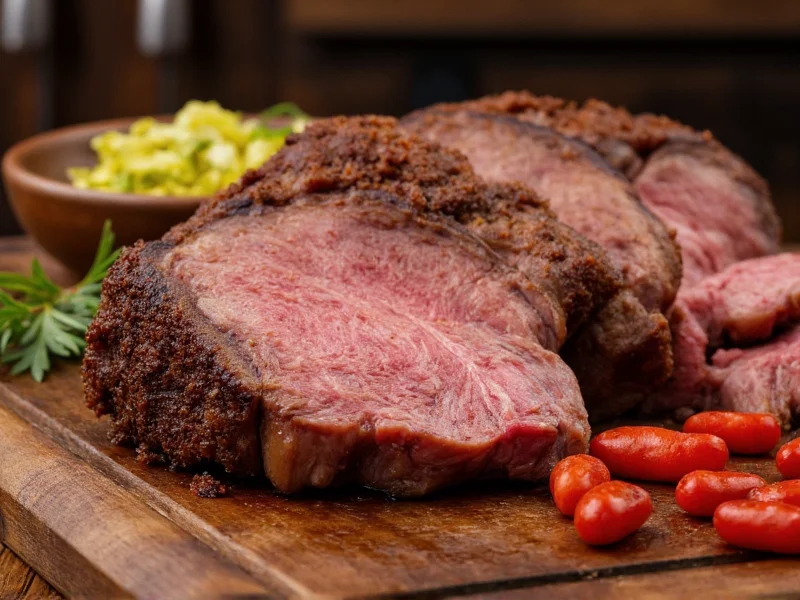When you see "short ribs" on a menu or at a butcher counter, you're looking at a beef cut. The confusion between beef and pork ribs is common since both animals have rib sections, but the term "short ribs" specifically refers to beef.
Understanding Short Ribs: A Complete Guide
Short ribs represent one of the most flavorful cuts in beef but often cause confusion among shoppers and home cooks. Let's clarify exactly what they are and why they're always beef.
What Makes Short Ribs Different From Other Rib Cuts
Short ribs come from the lower rib section of cattle, where the ribs are shorter and meatier than the upper rib cuts used for prime rib or ribeye steaks. Butchers cut across the bone, creating the characteristic "short" rib portions that typically measure 3-4 inches in length.
Pork ribs, by contrast, come from pigs and are categorized differently:
| Rib Type | Animal Source | Common Names | Characteristics |
|---|---|---|---|
| Short Ribs | Beef (cow) | Beef short ribs, Korean kalbi | Meaty, bone-in, from lower rib section |
| Spareribs | Pork (pig) | Pork spareribs, side ribs | Flatter, less meat, from belly side |
| Back Ribs | Pork (pig) | Meatback ribs, loin ribs | Meatier, curved, from loin section |
| Plate Ribs | Beef (cow) | Plate short ribs | Shorter, meatier than back ribs |
Why Short Ribs Are Always Beef: The Butcher's Perspective
The term "short ribs" originated in butchery terminology specifically for beef. When butchers prepare beef carcasses, they separate the rib section into different cuts. The upper portion becomes prime rib or ribeye, while the lower portion—where the ribs naturally shorten—becomes "short ribs."
Pork ribs don't have this same anatomical distinction. Pork ribs are categorized as spareribs (from the belly side) or back ribs (from the loin), but never as "short ribs." If you're looking at pork, you'll see terms like "baby back ribs" or "St. Louis style spareribs," but never "short ribs."
Common Misconceptions About Short Ribs
Several factors contribute to the confusion about whether short ribs are beef or pork:
- Terminology overlap: Both beef and pork have "ribs," but only beef has "short ribs" as a specific cut
- International variations: In Korean cuisine (kalbi), short ribs are often cut across the bone (flanken style), which some mistake for pork preparation
- Menu descriptions: Some restaurants simply say "rib" without specifying beef or pork
When shopping, always check the label. Reputable butchers and grocery stores will specify "beef short ribs" to avoid confusion with pork rib products.
Why Knowing the Difference Matters
Understanding that short ribs are beef, not pork, affects several practical considerations:
- Cooking methods: Beef short ribs require longer cooking times than pork ribs due to their tougher connective tissue
- Dietary restrictions: Those avoiding pork for religious or personal reasons need to know short ribs are beef
- Flavor profiles: Beef short ribs have a richer, more robust flavor than pork ribs
- Price points: Beef short ribs typically cost more than pork rib varieties
Shopping Tips for Authentic Short Ribs
When purchasing short ribs, look for these characteristics that confirm you're getting genuine beef short ribs:
- Bone structure: Beef short ribs have shorter, thicker bones compared to pork ribs
- Meat marbling: Visible fat marbling throughout the meat (more prominent in beef)
- Color: Deep red meat color (pork ribs appear lighter pink)
- Labeling: Should specifically say "beef short ribs" or "short ribs - beef"
Be wary of products simply labeled "ribs" without specifying the animal source, as this could indicate either beef or pork products.
Culinary Applications of Beef Short Ribs
Chefs prize beef short ribs for their rich flavor and ability to transform through slow cooking. Popular preparations include:
- Braised short ribs: Cooked low and slow until fork-tender
- Korean kalbi: Thinly sliced across the bone and marinated
- Barbecued short ribs: Smoked or grilled with dry rubs or sauces
- Stews and soups: Added for deep meaty flavor
The high collagen content in beef short ribs breaks down during cooking, creating that signature melt-in-your-mouth texture that makes them so desirable despite the confusion about their origin.











 浙公网安备
33010002000092号
浙公网安备
33010002000092号 浙B2-20120091-4
浙B2-20120091-4